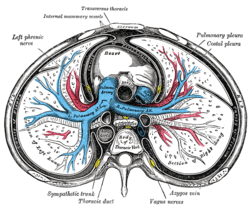Pulmonary artery
| Pulmonary artery | |
|---|---|
.svg.png)
 | |
| Details | |
| Precursor | truncus arteriosus |
| System | Cardiovascular, Respiratory |
| Source | right ventricle |
| Identifiers | |
| Latin | truncus pulmonalis, arteria pulmonalis |
| MeSH | A07.231.114.715 |
| TA | A12.2.01.001 |
| FMA | 8612 |
The pulmonary artery carries deoxygenated blood from the heart to the lungs.
Structure
In the human heart, the pulmonary trunk (pulmonary artery or main pulmonary artery) begins at the base of the right ventricle. It is short and wide—approximately 5 centimetres (2.0 in) in length and 3 centimetres (1.2 in) in diameter. It then branches into two pulmonary arteries (left and right), which deliver deoxygenated blood to the corresponding lung.
Embryology
The pulmonary arteries originate from the truncus arteriosus and the sixth pharyngeal arch. The truncus arteriosis is a structure that forms during the development of the heart as a successor to the conus arteriosus. [1]
By the third week of embryological life, the endocardial tubes have developed a swelling in the part closest to the heart. The swelling is known as the bulbus cordis and the upper part of this swelling develops into the truncus arteriosus [2] The structure is ultimately mesodermal in origin.[1] During development of the heart, the heart tissues undergo folding, and the truncus arteriosus is exposed to what will eventually be both the left and right ventricles. As a septum develops between the two ventricles of the heart, two bulges form on either side of the truncus arteriosus. These progressively enlarge until the trunk splits into the aorta and pulmonary arteries. [3]
During embryological life, the ductus arteriosis connects the pulmonary trunk and the arch of aorta, allowing blood to bypass the lungs.[4]
Function
The pulmonary artery carries deoxygenated blood from the right ventricle to the lungs. The blood here passes through capillaries adjacent to alveoli and becomes oxygenated as part of the process of respiration.
In contrast to the pulmonary arteries, the bronchial arteries supply nutrition to the lungs themselves.[5]
The pulmonary artery pressure (PA pressure) is a measure of the blood pressure found in the pulmonary artery. This is measured by inserting a catheter into the pulmonary artery.[6] :190–191 The mean pressure is typically 9 - 18 mmHg,[7] and the wedge pressure measured in the left atrium may be 6-12mmHg. The wedge pressure may be elevated in left heart failure,[6]:190–191 mitral valve stenosis, and other conditions, such as sickle cell disease.[8]
Clinical significance
The pulmonary artery is relevant in a number of clinical states. Pulmonary hypertension is used to describe an increase in the pressure of the pulmonary artery, and may be defined as a mean pulmonary artery pressure of greater than 25mmHg.[6]:720 This may occur as a result of heart problems such as heart failure, lung or airway disease such as COPD or scleroderma, or thromboembolic disease such as pulmonary embolism or emboli seen in sickle cell anaemia.[6]:720–721
Pulmonary embolism refers to an embolus that lodges in the pulmonary circulation. This may arise from a deep venous thrombosis, especially after a period of immobility. A pulmonary embolus is a common cause of death in patients with cancer and stroke.[6]:720–721 A large pulmonary embolus affecting the pulmonary trunk is called a saddle embolus.
Additional images
-

Image showing main pulmonary artery coursing ventrally to the aortic root and trachea, and the right pulmonary artery passes dorsally to the ascending aorta, while the left pulmonary artery passes ventrally to the descending aorta.
-

Pulmonary circuit
-

Transverse section of thorax, showing relations of pulmonary artery.
-

The position and relation of the esophagus in the cervical region and in the posterior mediastinum. Seen from behind.Crystal.
-
Pulmonary artery
-
Pulmonary artery.Deep dissection.Anterior view.
See also
- Chronic obstructive lung disease
- Pulmonary hypertension
- Thromboembolic disease
- Pulmonary artery sling
- Pulmonary circulation
- Rasmussen's aneurysm
External links
- 53805116 at GPnotebook
- Anatomy photo:20:01-0106 at the SUNY Downstate Medical Center - "Heart: The Pericardial sac and Great vessels"
- Anatomy photo:20:07-0105 at the SUNY Downstate Medical Center - "Heart: Openings of Great Vessels into the Pericardial Sac"
- Anatomy figure: 19:05-06 at Human Anatomy Online, SUNY Downstate Medical Center - "Mediastinal surface of the right lung."
- Anatomy figure: 19:06-02 at Human Anatomy Online, SUNY Downstate Medical Center - "Mediastinal surface of the left lung."
- Histology image: 13802loa – Histology Learning System at Boston University
References
- 1 2 Larsen 2009, p. 157.
- ↑ Larsen 2009, pp. 159-160.
- ↑ Larsen 2009, pp. 176-179.
- ↑ Braunwald, Eugene. Heart Disease: A Textbook of Cardiovascular Medicine (Fourth ed.). p. 791.
- ↑ Braunwald, Eugene. Heart Disease: A Textbook of Cardiovascular Medicine (4th ed.). p. 790.
- 1 2 3 4 5 edited by Nicki R. Colledge, Brian R. Walker, Stuart H. Ralston ; illustrated by Robert Britton (2010). Davidson's principles and practice of medicine. (21st ed.). Edinburgh: Churchill Livingstone/Elsevier. ISBN 978-0-7020-3084-0.
- ↑ Edwards Lifesciences LLC > Normal Hemodynamic Parameters – Adult 2009
- ↑ Pashankar FD, Carbonella J, Bazzy-Asaad A, Friedman A (April 2008). "Prevalence and risk factors of elevated pulmonary artery pressures in children with sickle cell disease". Pediatrics. 121 (4): 777–82. doi:10.1542/peds.2007-0730. PMID 18381543.
- Schoenwolf ... [et al.], Gary C. (2009). Larsen's human embryology (4th ed., Thoroughly rev. and updated. ed.). Philadelphia: Churchill Livingstone/Elsevier. pp. "Development of the Urogenital system". ISBN 9780443068119.